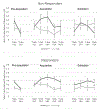Fear extinction learning as a predictor of response to cognitive behavioral therapy for pediatric obsessive compulsive disorder
- PMID: 30852257
- PMCID: PMC7422704
- DOI: 10.1016/j.janxdis.2019.02.005
Fear extinction learning as a predictor of response to cognitive behavioral therapy for pediatric obsessive compulsive disorder
Abstract
Background: While cognitive behavior therapy (CBT) is an effective treatment for many children and adolescents with Obsessive Compulsive Disorder (OCD), therapeutic response is variable. Fear conditioning and extinction are central constructs underlying exposure-based CBT. Fear extinction learning assessed prior to CBT may be a useful predictor of CBT response for guiding treatment decisions.
Methods: Sixty-four youth who participated in a randomized placebo-controlled trial of CBT with and without d-cycloserine (DCS) completed a fear conditioning task. Skin conductance response (SCR) scores were used to measure fear acquisition and extinction to determine whether extinction learning could predict CBT response.
Results: CBT responders and non-responders appeared to acquire conditioned fear SCRs in a similar manner. However, differences between treatment responders and non-responders emerged during the extinction phase. A responder (responder, non-responder) by conditioned stimulus type (CS+, CS-) interaction showed that CBT responders differentiated the stimulus paired with (CS+) and without (CS-) the unconditioned stimulus correctly during early and late extinction, whereas the CBT non-responders did not (p = .004).
Conclusions: While the small sample size makes conclusions tentative, this study supports an emerging literature that differential fear extinction may be an important factor underlying clinical correlates of pediatric OCD, including CBT response.
Keywords: CBT; Fear extinction; OCD; Pediatric; Skin resistance.
Copyright © 2019 Elsevier Ltd. All rights reserved.
Figures
Similar articles
-
Fear conditioning and extinction in pediatric obsessive-compulsive disorder.Ann Clin Psychiatry. 2017 Feb;29(1):17-26. Ann Clin Psychiatry. 2017. PMID: 28207912 Free PMC article. Clinical Trial.
-
FEAR CONDITIONING AND EXTINCTION IN YOUTH WITH OBSESSIVE-COMPULSIVE DISORDER.Depress Anxiety. 2016 Mar;33(3):229-37. doi: 10.1002/da.22468. Epub 2016 Jan 21. Depress Anxiety. 2016. PMID: 26799264 Free PMC article.
-
A preliminary study of D-cycloserine augmentation of cognitive-behavioral therapy in pediatric obsessive-compulsive disorder.Biol Psychiatry. 2010 Dec 1;68(11):1073-6. doi: 10.1016/j.biopsych.2010.07.015. Biol Psychiatry. 2010. PMID: 20817153 Free PMC article. Clinical Trial.
-
Extinction learning in childhood anxiety disorders, obsessive compulsive disorder and post-traumatic stress disorder: implications for treatment.Expert Rev Neurother. 2016 Oct;16(10):1155-74. doi: 10.1080/14737175.2016.1199276. Epub 2016 Jun 27. Expert Rev Neurother. 2016. PMID: 27275519 Free PMC article. Review.
-
[A Review and Recommendations of Evidence-Based Treatments for Pediatric Obsessive-Compulsive Disorder].Laeknabladid. 2016 Apr;102(4):179-85. doi: 10.17992/lbl.2016.04.75. Laeknabladid. 2016. PMID: 27197125 Review. Icelandic.
Cited by
-
A Psychometric Analysis of Fear of COVID-19 Scale in India.Int J Ment Health Addict. 2023;21(2):1256-1263. doi: 10.1007/s11469-021-00657-1. Epub 2021 Oct 4. Int J Ment Health Addict. 2023. PMID: 34629997 Free PMC article.
-
Getting Better with Age? A Review of Psychophysiological Studies of Fear Extinction Learning Across Development.Curr Top Behav Neurosci. 2023;64:213-236. doi: 10.1007/7854_2023_441. Curr Top Behav Neurosci. 2023. PMID: 37651043 Review.
-
Effects of Treatment Setting on Outcomes of Flexibly-Dosed Intensive Cognitive Behavioral Therapy for Pediatric OCD: A Randomized Controlled Pilot Trial.Front Psychiatry. 2021 May 17;12:669494. doi: 10.3389/fpsyt.2021.669494. eCollection 2021. Front Psychiatry. 2021. PMID: 34079488 Free PMC article.
-
Astrocytic glutamate transporter 1 (GLT1) deficient mice exhibit repetitive behaviors.Behav Brain Res. 2021 Jan 1;396:112906. doi: 10.1016/j.bbr.2020.112906. Epub 2020 Sep 17. Behav Brain Res. 2021. PMID: 32950606 Free PMC article.
-
Mechanisms of exposure and response prevention in obsessive-compulsive disorder: effects of habituation and expectancy violation on short-term outcome in cognitive behavioral therapy.BMC Psychiatry. 2022 Jan 27;22(1):66. doi: 10.1186/s12888-022-03701-z. BMC Psychiatry. 2022. PMID: 35086513 Free PMC article.
References
-
- Craske MG, Liao B, Brown L, & Vervliet B (2012). Role of inhibition in exposure therapy. J Exp Psychopathology, 3, 322–345.
Publication types
MeSH terms
Substances
Grants and funding
LinkOut - more resources
Full Text Sources
Medical


